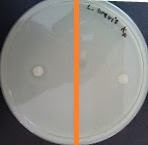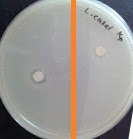An antimicrobial is a substance that kills or inhibits the growth of microorganisms such as bacteria, fungi, or protozoans. Antimicrobial drugs either kill microbes (microbiocidal) or prevent the growth of microbes (microbiostatic). Disinfectants are antimicrobial substances used on non-living objects or outside the body.
The history of antimicrobials begins with the observations of Pasteur and Joubert, who discovered that one type of bacteria could prevent the growth of another. They did not know at that time that the reason one bacterium failed to grow was that the other bacterium was producing an antibiotic. Technically, antibiotics are only those substances that are produced by one microorganism that kill, or prevent the growth, of another microorganism. Of course, in today's common usage, the term antibiotic is used to refer to almost any drug that attempts to rid your body of a bacterial infection. Antimicrobials include not just antibiotics, but synthetically formed compounds as well.
The discovery of antimicrobials like penicillin and tetracycline paved the way for better health for millions around the world. Before penicillin became a viable medical treatment in the early 1940s, no true cure for gonorrhea, strep throat, or pneumonia existed. Patients with infected wounds often had to have a wounded limb removed, or face death from infection. Now, most of these infections can be cured easily with a short course of antimicrobials.
However, with the development of antimicrobials, microorganisms have adapted and become resistant to previous antimicrobial agents. The old antimicrobial technology was based either on poisons or heavy metals, which may not have killed the microbe completely, allowing the microbe to survive, change, and become resistant to the poisons and/or heavy metals.
Antimicrobial nanotechnology is a recent addition to the fight against disease causing organisms, replacing heavy metals and toxins and may some day be a viable alternative.
Infections that are acquired during a hospital visit are called "hospital acquired infections" or nosocomial infections. Similarly, when the infectious disease is picked up in the non-hospital setting it is considered "community acquired".
Certain groups of bacteria can produce antimicrobial substances with the capacity to inhibit the growth of pathogenic and spoilage microorganisms. Organic acids, hydrogen peroxide, diacetyl and bacteriocins are included among these antimicrobial compounds. Interest in naturally produce antimicrobial agents, such as bacteriocins, is on the rise, since nowadys consumers demand "natural" and "minimally processed" food.
Bacteriocins comprise a large and diverse group of ribosomally synthesized antimicrobial proteins or peptides. Although bacteriocins can be found in numerous Gram-positive and Gram-negative bacteria, those produced by lactic acid bacteria (LAB) have received special attention in recent years due to their potential application in the food industry as natural biopreservatives. Different classes of LAB bacteriocins have been identified on the basis of biochemical and genetic characterization. These bacteriocins have been reported to inhibit the growth of Listeria monocyotogenes,Staphylococcus aureus, Enterococcus faecalis and Clostridium tyrobutyricum.
- To determine the antimicrobial effect of extracellular extracts of selected LAB strain.
Results:
 |
| L. plantarum ; P. aeruginosa |
 |
| L. brevis ; K. pneumoniae |
 |
| L. brevis ; S. aureus |
 |
| L. brevis ; P. aeruginosa |
 |
| L. casei ; K. pneumoniae |
 |
| L. casei ; S. aureus |
 |
| L. casei ; P. aeruginosa |
Strains
of LAB
|
Strains
of spoilage / Pathogenic Bacteria
|
Inhibition
Zone (cm)
|
L.plantarum
|
S.aureus
|
0.60
|
K.pneumoniae
|
1.15
|
|
P.aeruginosa
|
-
|
|
L.brevis
|
S.aureus
|
-
|
K.pneumoniae
|
0.70
|
|
P.aeruginosa
|
0.80
|
|
L.casei
|
S.aureus
|
-
|
K.pneumoniae
|
1.00
|
|
P.aeruginosa
|
0.65
|
- Part 2 : Determination of bacterion activity via optical density.
Strain of lab : L.plantarum
Dilution
|
OD600
of spoilage / pathogenic bacteria
|
||
Strain
1:
P.aeruginosa
|
Strain
2:
S.aureus
|
Strain
3:
K.pneumoniae
|
|
0x
|
-
|
-
|
-
|
2x
|
1.025
|
0.787
|
0.871
|
10x
|
0.733
|
0.722
|
0.595
|
50x
|
0.755
|
0.560
|
0.506
|
100x
|
0.260
|
0.321
|
0.237
|
Equation
|
Y= -0.2273X + 1.4888
|
Y= -0.156X + 1.1435
|
Y= -0.1991X + 1.2491
|
Positive
Control (Z)
|
0.432
|
0.270
|
0.829
|
50%
of Positive Control (Z/2)
|
0.216
|
0.135
|
0.4215
|
AU/mL
|
5.5996
|
6.4503
|
4.1919
|
Discussion:
- Part 1: Determination of bacteriocin activity via agar diffusion test.
Bacteriocin was extracted by cell free supernatant method and the crude supernatant was determined for its antagonistic activity. A well diffusion method was performed. In the activity it was observed that the bacteriocin produced by L.mesenteroides was effective against Salmonella typhi and Escherichia coli. But there was no effect against Shigella flexinerrae. The reviews say that the bacteriocins produced by L.mesenteroides are active against Salmonella typhimurium, Listeria monocytogenes, Staphylococcus aureus, Streptococcus faecalis, Escherichia coli, Bacillus cereus, L.monocytogenes has been considered as the major food borne pathogen and most activities were against them in food industries. Now these studies reveal the scope for bacteriocins, not only as preservatives but also as an antibiotic for many diseases and infections. Bacteriocin activity was determined in an agar well diffusion assay. To test the ability of the polyclonal antiserum to neutralize bacteriocin activity, serial dilutions of bacteriocin were mixed with an equal volume of undiluted antiserum in each well prior to adding the overlay. Preimmune serum and sterile deionized water were mixed with bacteriocin in the control wells. All tests were run in duplicate. This is an area around a paper disk or colony of bacteria(LAB) or mold where no other organisms are growing. If you are testing antibiotic sensitivity for example, you can impregnate paper disks with antibiotic and then put them on an agar plate of growing bacteria. The antibiotic then diffuses into the agar away from the disk. If the bacteria are sensitive to the antibiotic, they will not grow near the disk. The size of the zone is proportional to how sensitive the organism is. If the organism is resistant to the antibiotic, it will grow right up to the disk.
- Part 2 : Determination of bacterion activity via optical density.
A spectrometer (spectrophotometer, spectrograph or spectroscope) is an instrument used to measure properties of lightover a specific portion of the electromagnetic spectrum, typically used in spectroscopic analysis to identify materials. The variable measured is most often the light's intensity but could also, for instance, be the polarization state. The independent variable is usually the wavelength of the light or a unit directly proportional to the photon energy, such as wavenumber or electron volts, which has a reciprocal relationship to wavelength. A spectrometer is used in spectroscopy for producing spectral lines and measuring their wavelengths and intensities. Spectrometer is a term that is applied to instruments that operate over a very wide range of wavelengths, from gamma rays and X-rays into the far infrared. If the instrument is designed to measure the spectrum in absolute units rather than relative units, then it is typically called a spectrophotometer. The majority of spectrophotomers are used in spectral regions near the visible spectrum.
In general, any particular instrument will operate over a small portion of this total range because of the different techniques used to measure different portions of the spectrum. Below optical frequencies (that is, at microwave and radio frequencies), the spectrum analyzer is a closely related electronic device.
Conclusion:
LAB can produce a useful
bacterioncin such as L.plantarum, L.brevis,
and L.casei that can effectively
inhibit the growth of several pathogen such as K.pneumoniae, S.aureus and P.aeruginosa.
Bacteriocins from lactic acid bacteria are of importance in bioconservation of various foods. Moreover, the use of more than one LAB bacteriocin as a combination of biopreservative may have major applications in improving food safety. In the present study, the inhibitory effect of the cell-free filtrates of each of the 20 isolates was evaluated. Antimicrobial activity was observed for 6 isolates, and only against Gram positive bacteria. The biochemical nature of the antibacterial molecule produced by S. thermophilus T2 was studied in both the cell-free supernatant and the chloroform extract.
Bacteriocins from lactic acid bacteria are of importance in bioconservation of various foods. Moreover, the use of more than one LAB bacteriocin as a combination of biopreservative may have major applications in improving food safety. In the present study, the inhibitory effect of the cell-free filtrates of each of the 20 isolates was evaluated. Antimicrobial activity was observed for 6 isolates, and only against Gram positive bacteria. The biochemical nature of the antibacterial molecule produced by S. thermophilus T2 was studied in both the cell-free supernatant and the chloroform extract.
References:
- http://en.wikipedia.org/wiki/Antimicrobial
- http://en.wikipedia.org/wiki/Agar_diffusion_test
- http://mywebspace.quinnipiac.edu/erdonnald/BI298/Bacteriocins.pdf
- http://en.wikipedia.org/wiki/Zone_of_inhibition
- http://en.wikipedia.org/wiki/Lactic_acid_bacteria
- http://en.wikipedia.org/wiki/Lactic_acid_bacteria
- http://www.ruf.rice.edu/~bioslabs/methods/protein/spectrophotometer.html







No comments:
Post a Comment